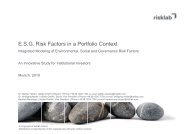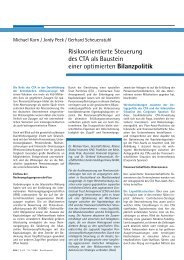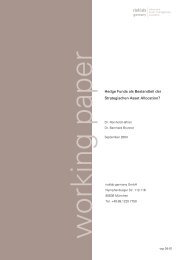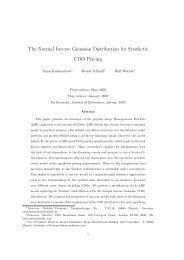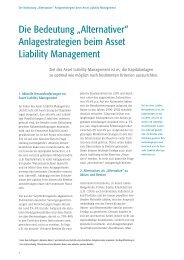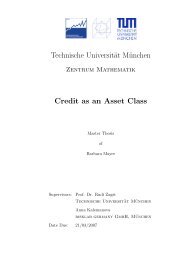Technical University Munich Commodities as an Asset Class - risklab
Technical University Munich Commodities as an Asset Class - risklab
Technical University Munich Commodities as an Asset Class - risklab
Create successful ePaper yourself
Turn your PDF publications into a flip-book with our unique Google optimized e-Paper software.
2.3 Trading <strong>Commodities</strong><br />
this, they are designed to meet investors needs <strong>an</strong>d separate them from commodity<br />
producer <strong>an</strong>d consumer requirements.<br />
Finally a regulatory ch<strong>an</strong>ge in commodity mutual fund markets will force the dem<strong>an</strong>d<br />
for commodity linked interest rate securities.<br />
2.3.1.5 Certificates<br />
A common vehicle to get commodity index exposure in Europe are certificates.<br />
Formally they securitize <strong>an</strong> obligation of the issuer with a regularly claim for interest<br />
coupon payments. That me<strong>an</strong>s that the investor does not purch<strong>as</strong>e stocks or shares<br />
of a mutual fund, he simply lends his money to the issuer. Certificates generally<br />
replicate the price evolvement of <strong>an</strong> underlying stock or index <strong>an</strong>d therefore count<br />
into the group of derivatives. A major characteristic of derivatives is to have a<br />
maturity: so do certificates. Nowadays, there are open-end versions, which include<br />
<strong>an</strong> internal rolling mech<strong>an</strong>ism. 50<br />
Certificates emerge the whole credit risk of the issuer what makes them <strong>an</strong> unattractive<br />
investment vehicle for institutional investors but they are very famous in retail<br />
business. The drawbacks of covered overpricing <strong>an</strong>d credit risk are little communicated.<br />
But their major adv<strong>an</strong>tage is high liquidity. Over this, certificates are generally<br />
available in m<strong>an</strong>y customized versions including refunding conditions equipped<br />
with guar<strong>an</strong>tees, bonuses, caps <strong>an</strong>d/or currency risk hedging facilities. Following<br />
[Zagst e.a. 2006] they c<strong>an</strong> be a perform<strong>an</strong>ce incre<strong>as</strong>ing addition to traditional stock<br />
<strong>an</strong>d bond retail portfolios.<br />
2.3.2 M<strong>an</strong>aged Futures Funds<br />
M<strong>an</strong>aged futures funds are m<strong>an</strong>aged by commodity trading advisors (CTAs). These<br />
trading advisors m<strong>an</strong>age client’s <strong>as</strong>sets by using global futures markets <strong>as</strong> <strong>an</strong> investment<br />
medium. This is the main difference between a CTA <strong>an</strong>d <strong>an</strong> ordinary trader.<br />
Former have research b<strong>as</strong>ed investment strategies, including diversification over different<br />
markets, risk m<strong>an</strong>aging <strong>an</strong>d loss limiting systems whereby ordinary traders<br />
generally are generally just experts in one market. In contr<strong>as</strong>t to traders, who are<br />
usually 100% in the market, CTA’s mainly just invest 10-25% of the <strong>as</strong>sets under<br />
m<strong>an</strong>agement to absorb losses while waiting for profitable trades. 51<br />
50 See [Gong Huber L<strong>an</strong>zinner 2006].<br />
51 See M<strong>an</strong>aged Account Research, Inc.;<br />
http : \ \ www.ma − research.com \ m<strong>an</strong>aged account vs self − directed.html<br />
39



